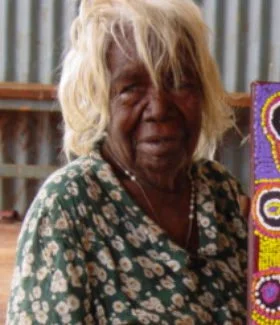MAGGIE WATSON NAPANGARDI
BIOGRAPHY

Maggie Watson began painting at 60 years of age and became the senior female artist at Yuendumu, 300 kilometres north west of Alice Springs by the time of her death some 19 years later in 2004. Located in the southern reach of Warlpiri land, Yuendumu had become the main community in which Warlipri people were settled after the 1950’s.
Maggie was a leader amongst a group of women artists who began to challenge the dominance of men’s acrylic painting in the Central Desert region from the mid 1980’s. The emergence of these women in Yuendumu and simultaneously in Utopia (amongst Anamtjerre and Alyawarre peoples) challenged the notion that men were the sole guardians of the visual life of these communities.The historical evolution of the movement of which Maggie was part, began with the encouragement of more permanent painting techniques in the 1970’s in both Yuendumu and Papunya, followed by the introduction of acrylic paints in the 1980’s. As the women artists progressed from painting ritual objects to painting on boards as a source of revenue they gained a wider audience. When the Warlukurlangu Artists cooperative was established in Yuendumu in the mid-1980’s, Maggie became the leader of a group of women whose work was included in the community’s first exhibition at the Araluen Arts Centre in Alice Springs in 1985. Their first commercial exhibition was held in 1987 at Sydney’s Hogarth Galleries and in the following year Maggie’s paintings were included in the exhibition Yuendumu, Paintings of the Desert at the South Australian Museum. This exhibition toured nationally and internationally.
Foremost amongst the major themes depicted by Maggie Watson, Dorothy Napangarti Robertson and other female Yuendumu artists is the important Warlpiri women’s Dreaming of the Karntakurlangu. This epic tale recounts the travel of a large group of ancestral women, the hair string belts they made to carry their babies and possessions, and the magical emergence of digging sticks which, quite literally, thrust themselves out of the ground before the women during the Dreaming, thereby equipping them for their vast travels. As the women danced their way across the desert in joyous exultation, they clutched the digging sticks in their outstretched hands. Dancing in a long line, they created important sites and encountered other Dreamings. Hundreds of these women travelled on the long journey first toward the east, then to the north, then south collecting plants and foods with both medicinal and ceremonial uses. They visited many sites, resting at some, going underground at others and later re-emerged morphing into different, sometimes malevolent, beings. These powerful ancestral women were involved in initiation ceremonies and used human hair-string spun and rubbed with special red ochre and fat as part of their magic just as women do to this day when performing ceremonies that connect them with their Jukurrpa. The digging sticks are regarded as symbolically manifest as desert oaks growing in their homeland near Mina Mina, a central location for much of the story that relates to Warlpiri lands west of Yuendumu. It is this narrative that preoccupied her work and was most superbly illustrated in what is considered her Magnum Opus.
Maggie Watson’s paintings are characterised by the linear precision created by dots applied in alternating bands of colour. When viewed in varying arrays across the canvas these meticulously applied textured striations impart a rhythmic trance-like quality thereby evoking the movement of lines of women as they dance and their repeated chanting during the ceremony. Maggie’s willingness to adopt the shiny surfaced acrylic paints was founded on the Warlpiri’s response to shimmering surfaces associated with beauty and reminiscent of the ancestral beings completely beautified upon their original emergence. In time her use of flamboyant colour and richly textured surfaces became the hallmark of her paintings. Her works were colourful but never garishly so and often featured subtle pastel shades such as soft yellows, splashes of a luscious turquoise and the clear blue reminiscent of a summer sky. Her best works had a strong painterly quality and while meticulously executed, they imparted that joyous sense of abandon.
Maggie Watson created paintings for 15 years but was never a prolific artist. She worked only sporadically for the Warlurkulangu Art Centre in Yuendumu after the formative period in the late 1980’s. The vast majority of her limited output was produced while working with Peter van Groessen, the husband of one of her daughters who maintained studio working spaces in Adelaide and Alice Springs from the beginning of the 1990’s. These paintings were principally sold through Kimberley Art in Melbourne and the Chicago Gallery that they maintained. They include almost all of her larger works that have been responsible for her growing reputation since 2000 as the most successful Aboriginal female artist after Emily Kngwarreye. Her works have been featured in many major collections, including The National Gallery of Australia and the Musee National Des Arts Africain et Oceaniens in Paris.
Maggie was a major participant in the 7 x 3 m canvas that was commissioned in 1991 and exhibited in the 1993 European touring exhibition Aratjara – Australian Aboriginal Art, curated by the Kunstsammlung Nordrhein Westfalen in Dusseldorf, West Germany, and her work was included in the Australian National Gallery Warlpiri collection commissioned in 1992. Following her death Maggie Watson’s work was exhibited in the major exhibition Colour Power – Aboriginal Art Post 1984 at the National Gallery of Victoria.
© Adrian Newstead
References
West, M (ed). 1988. The Inspired Dream, Queensland Art Gallery, Brisbane.
Nicholls, Christine. ‘The Three Napangardi’s. To The Memory of Maggie Napangardi Watson,’ Colour and Power, Aboriginal Art Post 1984, In the Collection of the National Gallery of Victoria, Judith Ryan.

